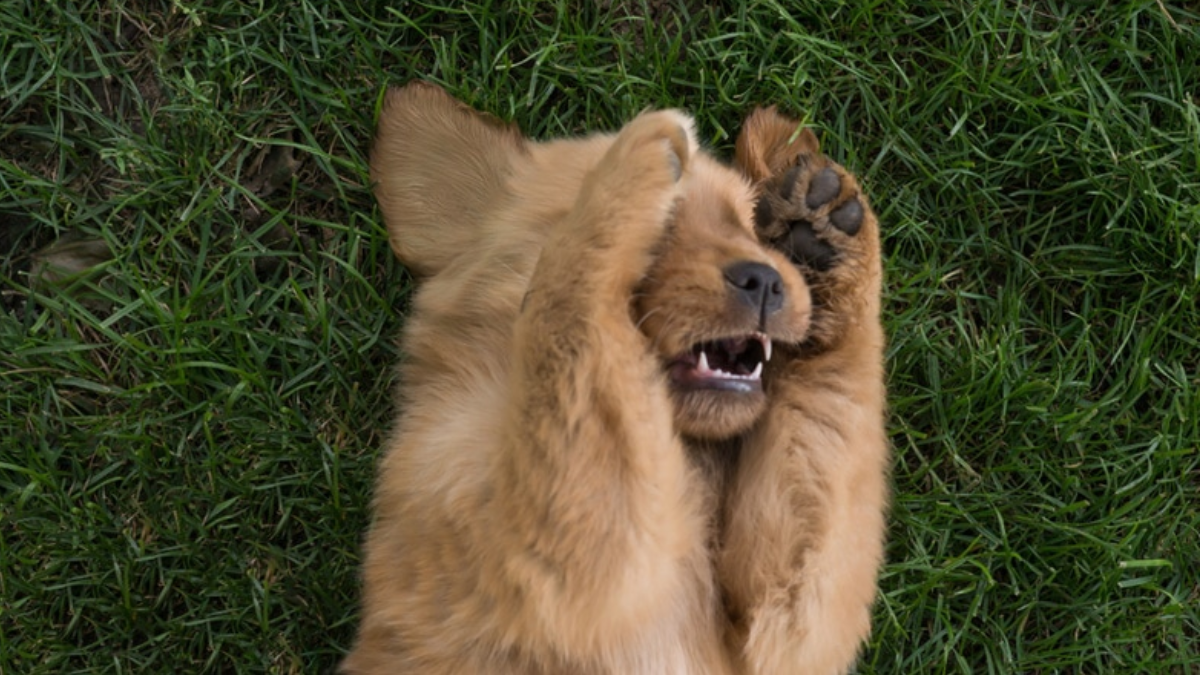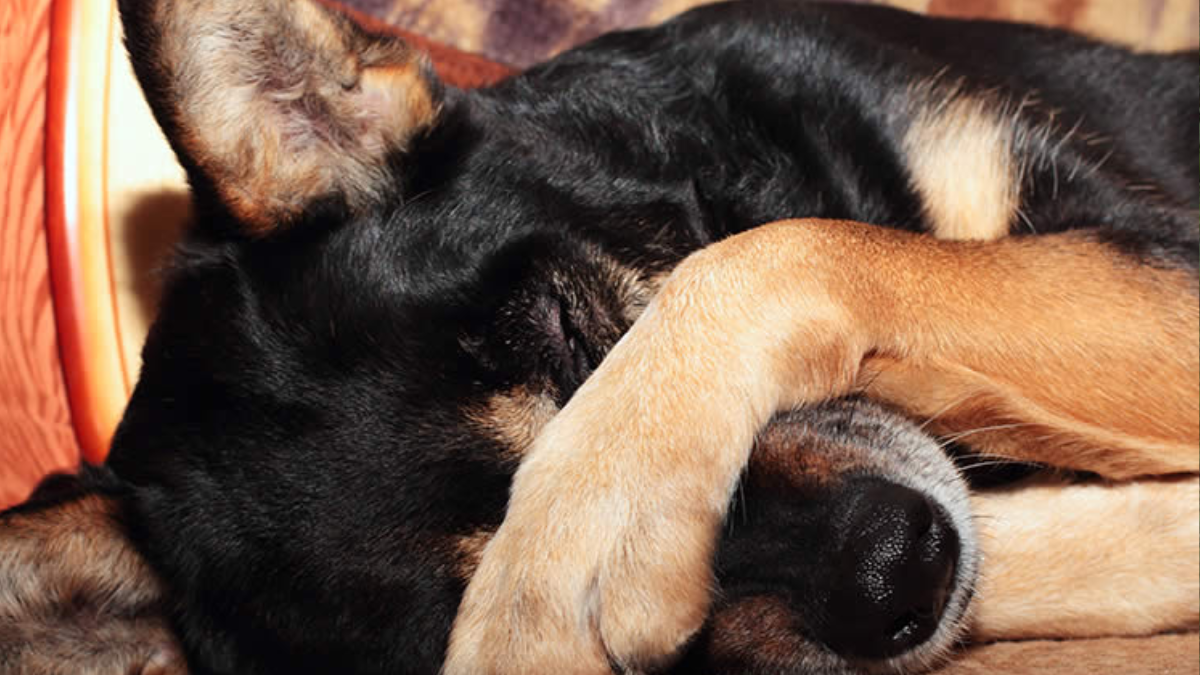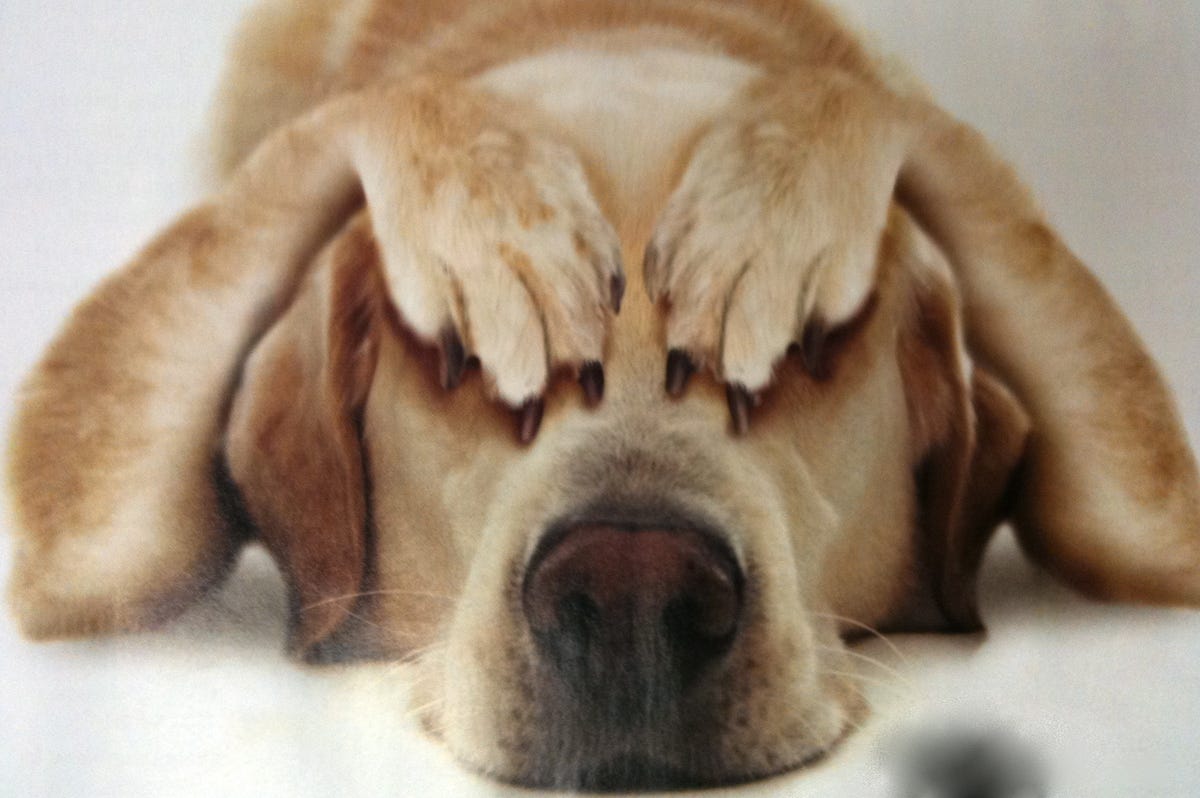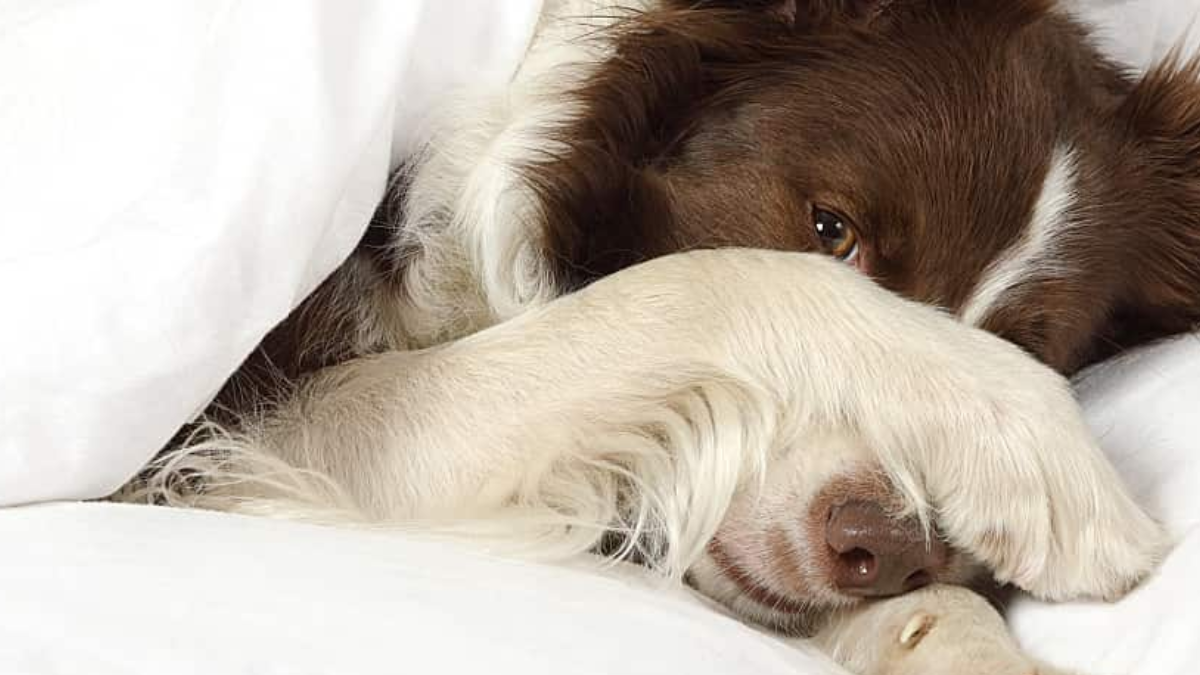Dogs have a unique way of communicating with their owners and other animals. Sometimes, their actions can be confusing, leaving owners wondering what their pet is trying to tell them. One such action is when a dog covers its eyes with its paws. What Does It Mean When a Dog Covers Their Eyes with Paws? It can be difficult to understand the meaning behind this behavior, but there are a few possible explanations. This behavior may serve as a self-soothing mechanism or a signal of distress.

Whether it's seeking solace from overwhelming stimuli, expressing feelings of vulnerability, or simply seeking comfort, the context in which the behavior occurs is essential for interpretation. Understanding the context, such as the dog's surroundings and body language, is crucial in deciphering the underlying message. Dog owners need to pay attention to these subtle cues and respond accordingly, providing reassurance and support when needed. By fostering a strong bond and open communication with their canine companions, owners can better address any concerns and ensure their pet's well-being.
One possible reason why a dog might cover its eyes with its paws is that it is feeling anxious or stressed. Dogs can become overwhelmed by their environment or situations, causing them to feel uneasy. Covering their eyes with their paws can be a way for them to cope with these feelings and block out stimuli that are causing them stress.
Another possible reason for this behavior is that the dog is feeling sleepy or tired. Just like humans, dogs can become drowsy and may cover their eyes with their paws as a way to block out light and rest. This is particularly common in puppies who may need more sleep than adult dogs. Understanding the reason behind this behavior can help owners better communicate with their pets and provide them with the care they need.
Understanding Canine Body Language
Dogs communicate through various means, including vocalizations and body language. Understanding their body language can help you better understand your furry friend's emotions and needs. Here are some key points to keep in mind when interpreting canine body language.
Communication Through Actions
Dogs use their bodies to communicate their emotions and intentions. For example, when a dog wags its tail, it is usually a sign of happiness and excitement. Similarly, when a dog covers its eyes with its paws, it may be a sign of discomfort or anxiety.
Signs of Stress and Anxiety
Dogs can experience stress and anxiety just like humans do. Signs of stress and anxiety in dogs can include panting, pacing, trembling, and avoidance behaviors. If you notice these signs in your dog, it may be a sign that they are feeling stressed or anxious.

It's important to remember that context is key when interpreting canine body language. For example, a dog covering its eyes with its paws may simply be trying to get some rest or seeking comfort. However, if the behavior is accompanied by other signs of stress or anxiety, it may be a sign that your dog is feeling overwhelmed.
As pack animals, dogs are highly attuned to social cues and body language. By learning to interpret your dog's body language, you can better understand their needs and build a stronger bond based on trust and communication.
Common Reasons Dogs Cover Their Eyes
Dogs are known for their adorable and sometimes quirky behavior, and one such behavior is covering their eyes with their paws. This behavior may seem strange to some dog owners, but it is quite common and can be attributed to various reasons.
Seeking Comfort or Protection
One of the most common reasons why dogs cover their eyes with their paws is to seek comfort or protection. Dogs may feel scared or anxious in certain situations, and covering their eyes can help them feel more secure. This behavior is often seen in dogs who are afraid of loud noises, such as thunder or fireworks, or when they are in unfamiliar surroundings.

Displaying Submission or Affection
Dogs may also cover their eyes as a way of displaying submission or affection. This behavior is often seen in dogs who are interacting with other dogs or humans. By covering their eyes, dogs are showing that they trust the other party and are willing to submit to them. This behavior can also be seen as a sign of affection, as dogs may cover their eyes while cuddling or being petted.
Responding to Physical Discomfort
In some cases, dogs may cover their eyes as a way of responding to physical discomfort or pain. This behavior is often seen in dogs who are experiencing discomfort or pain in their eyes or head. By covering their eyes, dogs are trying to alleviate the discomfort and soothe themselves. This behavior can also be seen in dogs who have a headache or are experiencing other types of physical discomfort.
In conclusion, dogs cover their eyes with their paws for various reasons, including seeking comfort or protection, displaying submission or affection, and responding to physical discomfort. This behavior is a natural and self-soothing behavior that dogs use to cope with various situations. As a dog owner, it is important to understand your dog's behavior and respond accordingly to ensure their comfort and well-being.
Behavioral and Emotional Aspects
Dogs are known to exhibit various behaviors that communicate their emotions and feelings. One such behavior is when a dog covers its eyes with its paws. This behavior can indicate several emotional and behavioral aspects that the dog is experiencing.
Anxiety and Stress Indicators
When a dog covers its eyes with its paws, it can be an indicator of anxiety or stress. Dogs may do this when they are in stressful situations or when they feel uncomfortable. It can also be a sign of fear or embarrassment. Dogs that are anxious or stressed may also exhibit other behaviors such as pacing, panting, or whining.

Seeking Attention and Affection
Another reason why a dog may cover its eyes with its paws is to seek attention and affection from its owner. Dogs that crave attention may use this behavior as a way to get positive attention from their owners. They may also do this when they want to cuddle or be petted.
It is important to note that this behavior can also be a learned behavior. If a dog has received positive attention from its owner in the past when it covers its eyes with its paws, it may continue to do so in the future.
Overall, it is essential to understand your dog's behavior and emotions to ensure their well-being. If you notice your dog exhibiting this behavior frequently, it is best to consult with a veterinarian or a professional dog trainer to address any underlying issues.
Physical Causes for Pawing at Eyes
Dogs use their paws to scratch and rub their eyes for various reasons. Here are some of the most common physical causes for pawing at the eyes:
Scratching an Itch or Irritation
Dogs may paw at their eyes to relieve an itch or irritation caused by allergies, fleas, or other irritants. If the pawing is persistent, it may cause further irritation or injury to the eye, leading to more serious problems.
Medical Issues and Allergies
Pawing at the eyes may also be a sign of underlying medical issues or allergies. Dogs with eye infections, glaucoma, or cataracts may paw at their eyes to relieve pain or discomfort. Allergies to pollen, dust, or other environmental factors can also cause eye irritation and lead to pawing.

Injury and Pain Management
In some cases, pawing at the eyes may be a sign of injury or pain. Dogs with corneal ulcers, foreign objects in the eye, or other eye injuries may paw at their eyes to try to remove the source of discomfort. Painful conditions such as headaches or migraines can also cause dogs to paw at their eyes.
If a dog is pawing at their eyes persistently, it is important to take them to a vet for evaluation. The vet can determine the underlying cause of the pawing and recommend appropriate treatment options to address the issue.
Interpreting Contextual Clues
Dogs are known for their expressive behavior, and one of the most common gestures they make is covering their eyes with their paws. While this behavior may seem cute and harmless, it could be an indication of an underlying issue. Interpreting contextual clues can help pet owners understand the cause of this behavior and take appropriate action.
Environmental and Social Factors
The environment and social factors play a crucial role in a dog's behavior. If a dog feels threatened or anxious, it may cover its eyes with its paws as a way to block out the stimuli causing the discomfort. Similarly, if a dog is in a new or unfamiliar environment, it may use this gesture to signal that it needs some time to adjust.

Additionally, dogs may cover their eyes with their paws during playtime as a way to signal that they are ready to play. This behavior can also be a sign of trust and a bond between the pet parent and the dog.
Owner-Dog Interaction
The relationship between the pet parent and the dog is also an important factor to consider. If a dog perceives its owner as the pack leader and feels safe and secure in their presence, it may use this gesture as a way to show its submission and respect. On the other hand, if a dog does not trust its owner or feels threatened by it, it may cover its eyes with its paws as a way to avoid eye contact and confrontation.
Positive reinforcement and learned behavior also play a role in a dog's tendency to cover its eyes with its paws. If a pet parent rewards this behavior, the dog may continue to do it as a way to seek attention or treats.
In conclusion, interpreting contextual clues is essential for understanding a dog's behavior, including why it covers its eyes with its paws. By considering environmental and social factors and the owner-dog interaction, pet parents can take appropriate action to ensure their furry friend's well-being.
Addressing and Alleviating Behavior
Dogs exhibit a variety of behaviors that can be puzzling to their owners. One such behavior is when a dog covers their eyes with their paws. This behavior can be a sign of stress, anxiety, or simply a learned behavior. Regardless of the cause, there are several ways to address and alleviate this behavior.
Training and Positive Reinforcement
Training is a crucial part of addressing negative behavior in dogs. Positive reinforcement techniques, such as rewarding good behavior, can be an effective way to encourage your dog to stop covering their eyes with their paws. Consistency is key when it comes to training, so be sure to reward your dog every time they exhibit the desired behavior.
Creating a Safe and Comfortable Environment
Dogs often cover their eyes with their paws when they are feeling stressed or anxious. Creating a safe and comfortable environment for your dog can help alleviate these feelings. This can include providing a cozy bed, a safe space for your dog to retreat to, and plenty of opportunities for exercise and play.

Consulting with a Veterinarian
If your dog's behavior persists despite your best efforts, it may be time to consult with a veterinarian. They can help rule out any underlying medical conditions that may be contributing to your dog's behavior. They can also guide additional steps you can take to address the behavior.
In conclusion, dogs cover their eyes with their paws for a variety of reasons. By using positive reinforcement techniques, creating a safe and comfortable environment, and consulting with a veterinarian if necessary, you can address and alleviate this behavior.
Conclusion
In conclusion, interpreting what it means when a dog covers their eyes with their paws requires careful observation and consideration of various factors. What Does It Mean When a Dog Covers Their Eyes with Paws? While dogs don't cover their eyes in the same way humans do, this behavior may signify emotional distress, seeking comfort, or expressing vulnerability.
Understanding the context, such as the dog's surroundings and body language, is crucial in deciphering the underlying message. Dog owners need to pay attention to these subtle cues and respond accordingly, providing reassurance and support when needed. By fostering a strong bond and open communication with their canine companions, owners can better address any concerns and ensure their pet's well-being.
Frequently Asked Questions (FAQs)
- Why do dogs cover their eyes with their paws when you pet them?
- Dogs may cover their eyes with their paws when they are feeling overwhelmed or anxious. This behavior is a way for them to block out some of the stimulation and feel more secure. It can also be a sign that they are enjoying the petting and want to savor the moment.
- What does it signify when a dog rubs its face with its paws after being petted?
- When a dog rubs its face with its paws after being petted, it can be a sign that they are trying to get rid of the scent of the person who petted them. This behavior can also be a way for them to self-soothe and release tension.
- Is there a reason dogs rub their faces with their paws?
- Dogs may rub their faces with their paws to clean their eyes or remove debris from their fur. This behavior can also be a way for them to mark their scent on objects or people.
- What does it mean when dogs cover their eyes while playing?
- When dogs cover their eyes while playing, it can be a sign that they are feeling vulnerable or submissive. This behavior can also be a way for them to signal to other dogs that they are not a threat and want to play.
- Why might a dog cover his face with his paws while sleeping?
- Dogs may cover their face with their paws while sleeping to block out light or other stimuli. This behavior can also be a way for them to feel more secure and protected while they rest.
- What could it indicate if a dog keeps rubbing its face with its paws?
- If a dog keeps rubbing its face with its paws, it could be a sign of an underlying medical issue such as allergies or an eye infection. It is important to consult with a veterinarian if this behavior persists.




